A Detailed Analysis: Impact of Technology on Art and Music Industry
VerifiedAdded on 2023/06/01
|11
|1954
|120
Essay
AI Summary
This essay examines the pervasive influence of technology on the art and music industries, highlighting both the opportunities and challenges it presents. It discusses the emergence of digital art, the evolution of music production and accessibility, and the pressures faced by artists and companies in a...
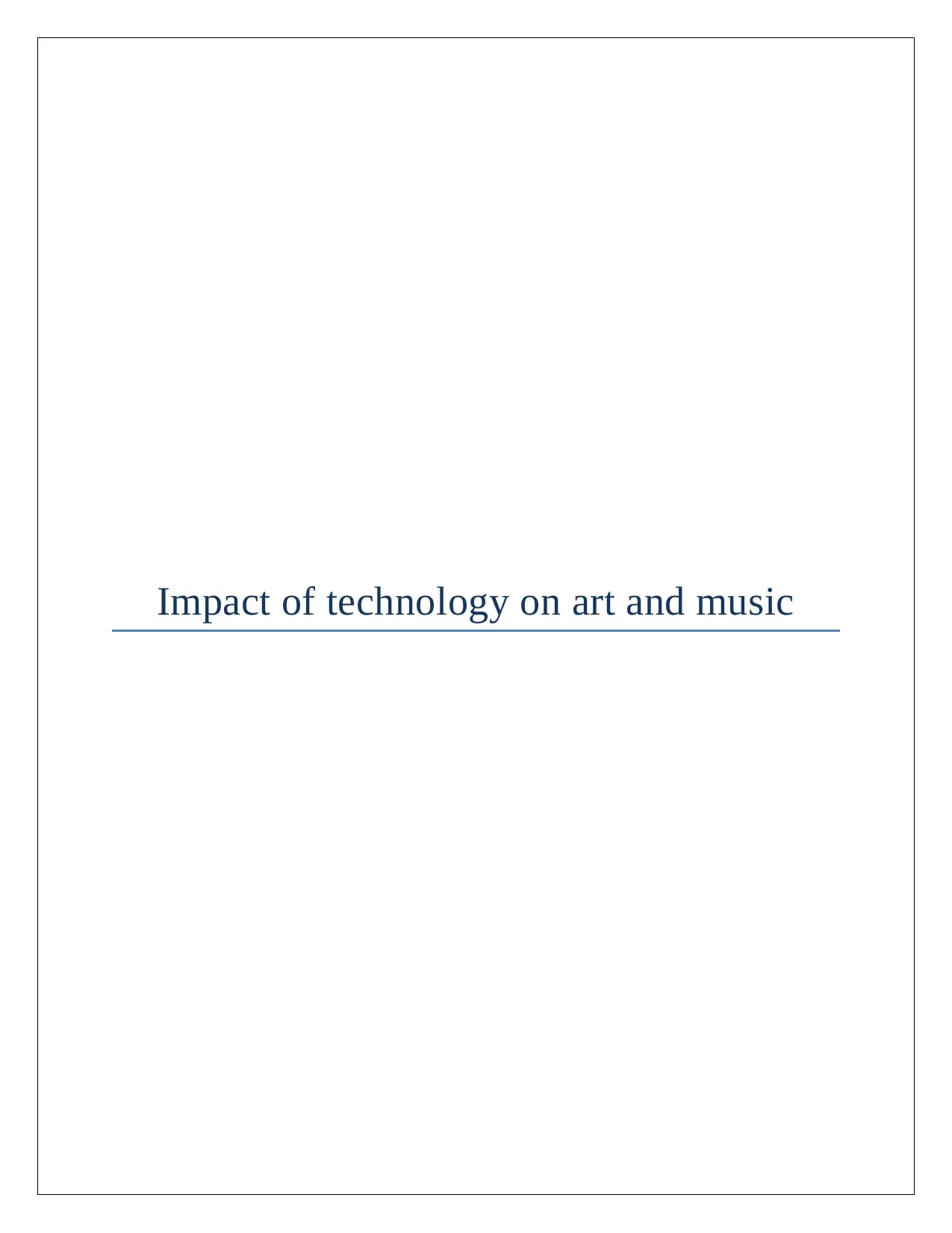
Impact of technology on art and music
Paraphrase This Document
Need a fresh take? Get an instant paraphrase of this document with our AI Paraphraser

Table of Contents
Introduction.................................................................................................................................................3
Analysis.......................................................................................................................................................3
Conclusion.................................................................................................................................................10
References.................................................................................................................................................12
Introduction.................................................................................................................................................3
Analysis.......................................................................................................................................................3
Conclusion.................................................................................................................................................10
References.................................................................................................................................................12
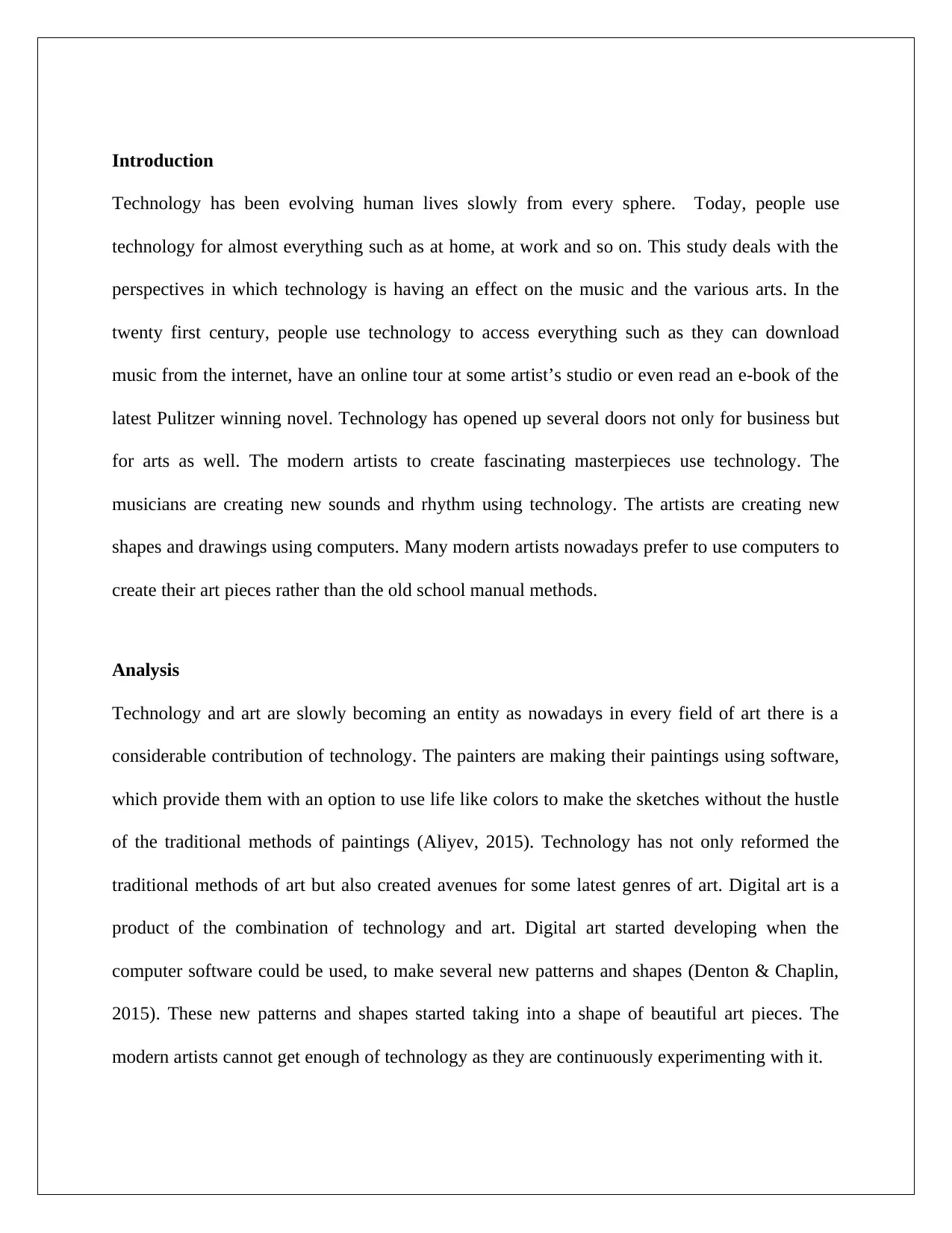
Introduction
Technology has been evolving human lives slowly from every sphere. Today, people use
technology for almost everything such as at home, at work and so on. This study deals with the
perspectives in which technology is having an effect on the music and the various arts. In the
twenty first century, people use technology to access everything such as they can download
music from the internet, have an online tour at some artist’s studio or even read an e-book of the
latest Pulitzer winning novel. Technology has opened up several doors not only for business but
for arts as well. The modern artists to create fascinating masterpieces use technology. The
musicians are creating new sounds and rhythm using technology. The artists are creating new
shapes and drawings using computers. Many modern artists nowadays prefer to use computers to
create their art pieces rather than the old school manual methods.
Analysis
Technology and art are slowly becoming an entity as nowadays in every field of art there is a
considerable contribution of technology. The painters are making their paintings using software,
which provide them with an option to use life like colors to make the sketches without the hustle
of the traditional methods of paintings (Aliyev, 2015). Technology has not only reformed the
traditional methods of art but also created avenues for some latest genres of art. Digital art is a
product of the combination of technology and art. Digital art started developing when the
computer software could be used, to make several new patterns and shapes (Denton & Chaplin,
2015). These new patterns and shapes started taking into a shape of beautiful art pieces. The
modern artists cannot get enough of technology as they are continuously experimenting with it.
Technology has been evolving human lives slowly from every sphere. Today, people use
technology for almost everything such as at home, at work and so on. This study deals with the
perspectives in which technology is having an effect on the music and the various arts. In the
twenty first century, people use technology to access everything such as they can download
music from the internet, have an online tour at some artist’s studio or even read an e-book of the
latest Pulitzer winning novel. Technology has opened up several doors not only for business but
for arts as well. The modern artists to create fascinating masterpieces use technology. The
musicians are creating new sounds and rhythm using technology. The artists are creating new
shapes and drawings using computers. Many modern artists nowadays prefer to use computers to
create their art pieces rather than the old school manual methods.
Analysis
Technology and art are slowly becoming an entity as nowadays in every field of art there is a
considerable contribution of technology. The painters are making their paintings using software,
which provide them with an option to use life like colors to make the sketches without the hustle
of the traditional methods of paintings (Aliyev, 2015). Technology has not only reformed the
traditional methods of art but also created avenues for some latest genres of art. Digital art is a
product of the combination of technology and art. Digital art started developing when the
computer software could be used, to make several new patterns and shapes (Denton & Chaplin,
2015). These new patterns and shapes started taking into a shape of beautiful art pieces. The
modern artists cannot get enough of technology as they are continuously experimenting with it.
You're viewing a preview
Unlock full access by subscribing today!
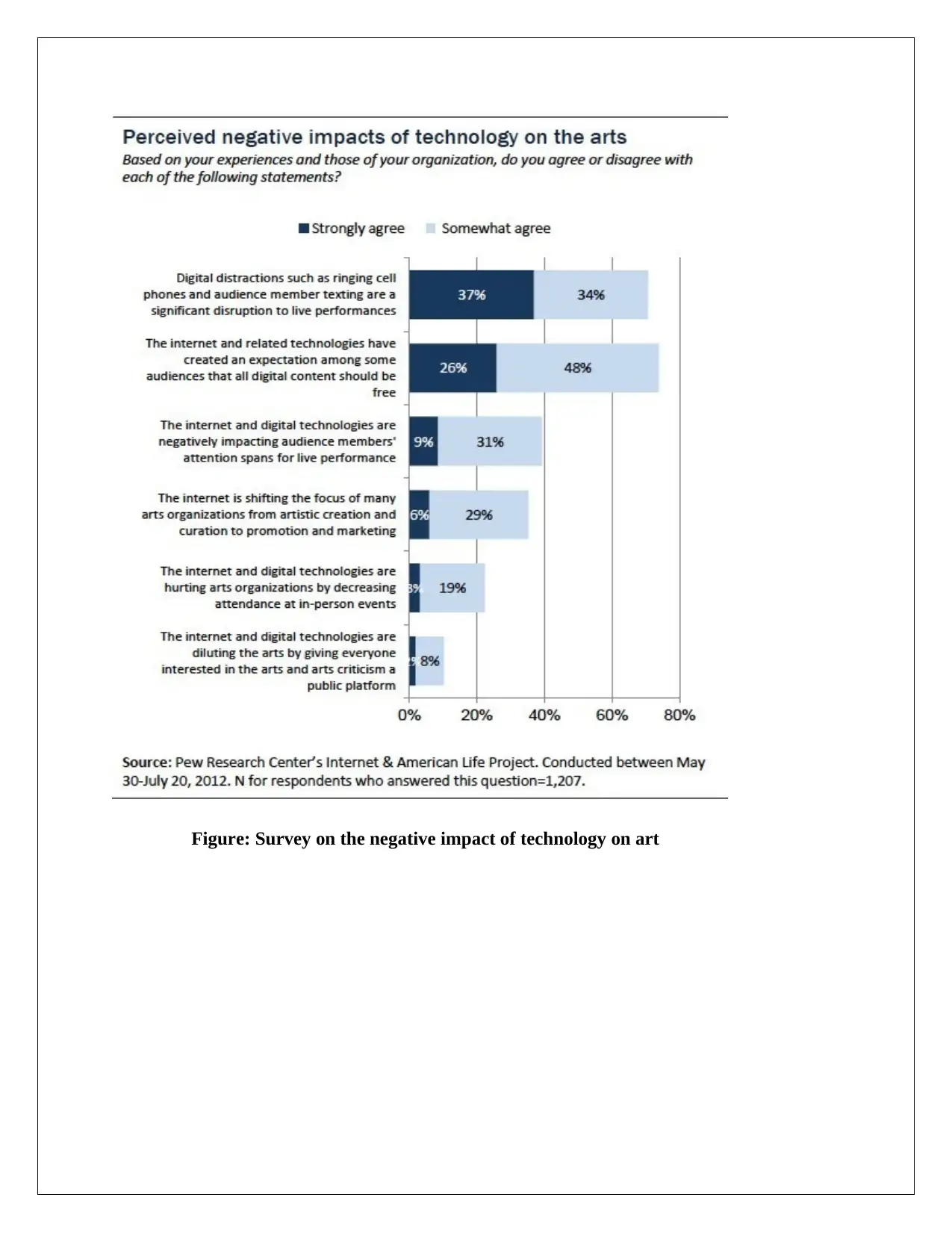
Figure: Survey on the negative impact of technology on art
Paraphrase This Document
Need a fresh take? Get an instant paraphrase of this document with our AI Paraphraser
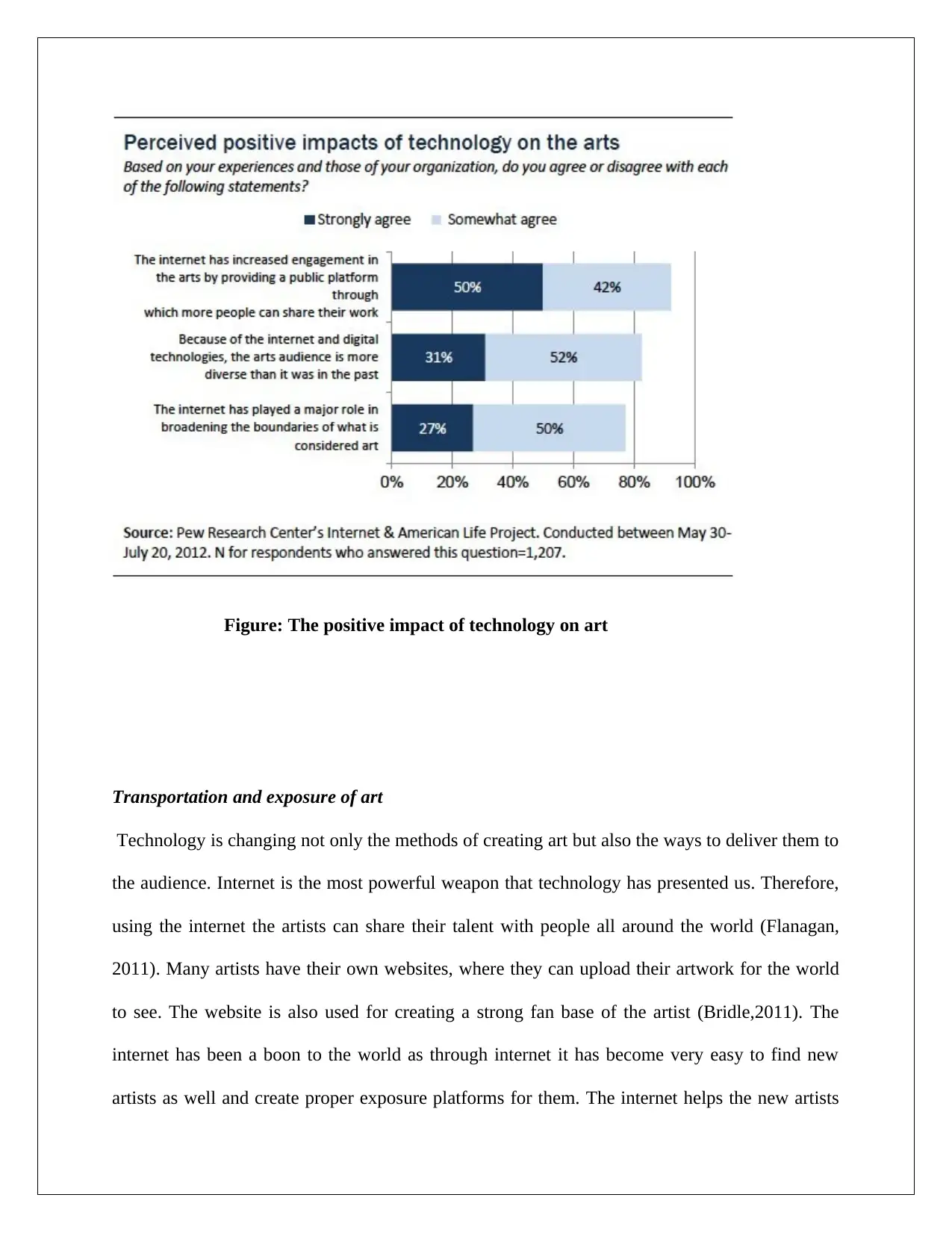
Figure: The positive impact of technology on art
Transportation and exposure of art
Technology is changing not only the methods of creating art but also the ways to deliver them to
the audience. Internet is the most powerful weapon that technology has presented us. Therefore,
using the internet the artists can share their talent with people all around the world (Flanagan,
2011). Many artists have their own websites, where they can upload their artwork for the world
to see. The website is also used for creating a strong fan base of the artist (Bridle,2011). The
internet has been a boon to the world as through internet it has become very easy to find new
artists as well and create proper exposure platforms for them. The internet helps the new artists
Transportation and exposure of art
Technology is changing not only the methods of creating art but also the ways to deliver them to
the audience. Internet is the most powerful weapon that technology has presented us. Therefore,
using the internet the artists can share their talent with people all around the world (Flanagan,
2011). Many artists have their own websites, where they can upload their artwork for the world
to see. The website is also used for creating a strong fan base of the artist (Bridle,2011). The
internet has been a boon to the world as through internet it has become very easy to find new
artists as well and create proper exposure platforms for them. The internet helps the new artists
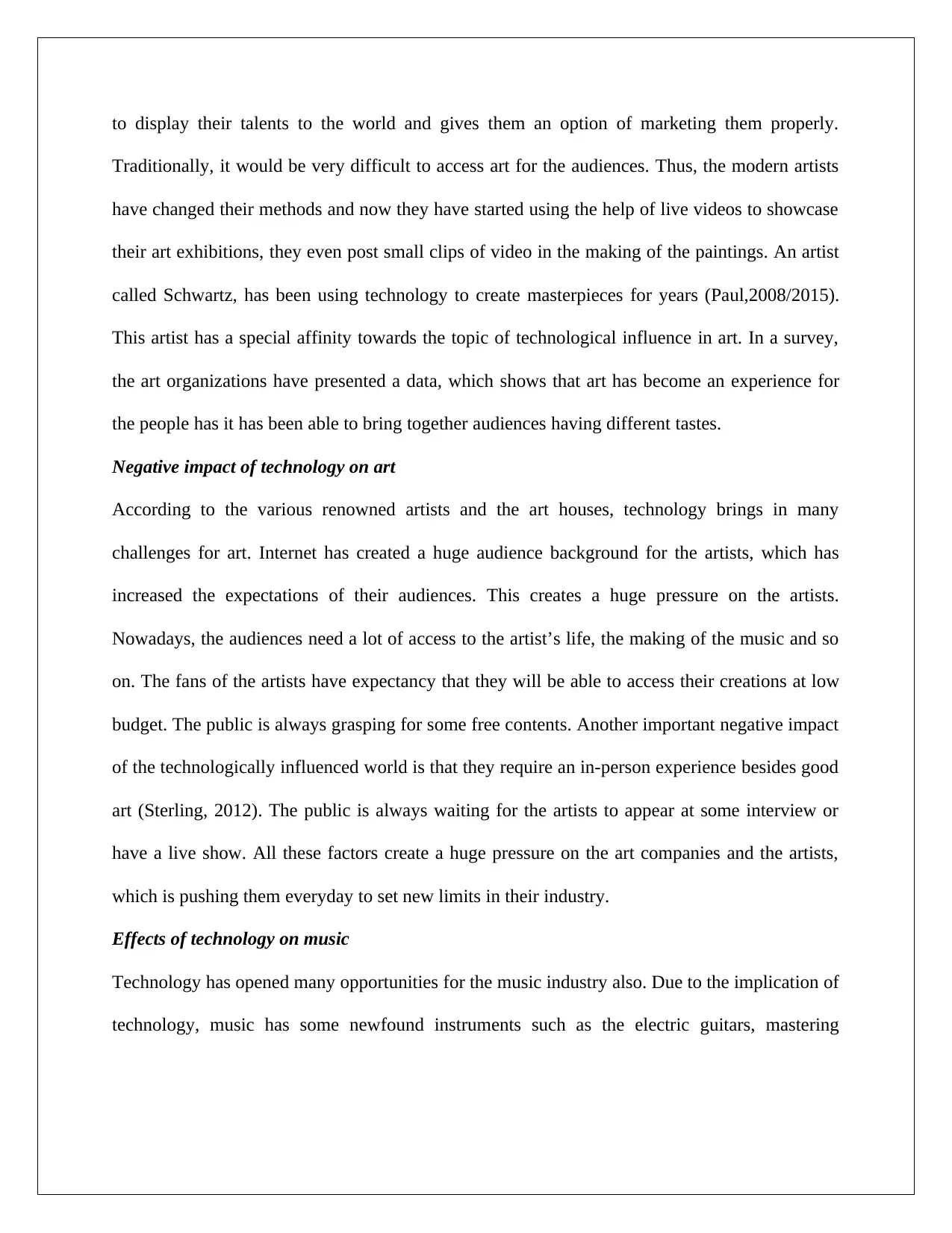
to display their talents to the world and gives them an option of marketing them properly.
Traditionally, it would be very difficult to access art for the audiences. Thus, the modern artists
have changed their methods and now they have started using the help of live videos to showcase
their art exhibitions, they even post small clips of video in the making of the paintings. An artist
called Schwartz, has been using technology to create masterpieces for years (Paul,2008/2015).
This artist has a special affinity towards the topic of technological influence in art. In a survey,
the art organizations have presented a data, which shows that art has become an experience for
the people has it has been able to bring together audiences having different tastes.
Negative impact of technology on art
According to the various renowned artists and the art houses, technology brings in many
challenges for art. Internet has created a huge audience background for the artists, which has
increased the expectations of their audiences. This creates a huge pressure on the artists.
Nowadays, the audiences need a lot of access to the artist’s life, the making of the music and so
on. The fans of the artists have expectancy that they will be able to access their creations at low
budget. The public is always grasping for some free contents. Another important negative impact
of the technologically influenced world is that they require an in-person experience besides good
art (Sterling, 2012). The public is always waiting for the artists to appear at some interview or
have a live show. All these factors create a huge pressure on the art companies and the artists,
which is pushing them everyday to set new limits in their industry.
Effects of technology on music
Technology has opened many opportunities for the music industry also. Due to the implication of
technology, music has some newfound instruments such as the electric guitars, mastering
Traditionally, it would be very difficult to access art for the audiences. Thus, the modern artists
have changed their methods and now they have started using the help of live videos to showcase
their art exhibitions, they even post small clips of video in the making of the paintings. An artist
called Schwartz, has been using technology to create masterpieces for years (Paul,2008/2015).
This artist has a special affinity towards the topic of technological influence in art. In a survey,
the art organizations have presented a data, which shows that art has become an experience for
the people has it has been able to bring together audiences having different tastes.
Negative impact of technology on art
According to the various renowned artists and the art houses, technology brings in many
challenges for art. Internet has created a huge audience background for the artists, which has
increased the expectations of their audiences. This creates a huge pressure on the artists.
Nowadays, the audiences need a lot of access to the artist’s life, the making of the music and so
on. The fans of the artists have expectancy that they will be able to access their creations at low
budget. The public is always grasping for some free contents. Another important negative impact
of the technologically influenced world is that they require an in-person experience besides good
art (Sterling, 2012). The public is always waiting for the artists to appear at some interview or
have a live show. All these factors create a huge pressure on the art companies and the artists,
which is pushing them everyday to set new limits in their industry.
Effects of technology on music
Technology has opened many opportunities for the music industry also. Due to the implication of
technology, music has some newfound instruments such as the electric guitars, mastering
You're viewing a preview
Unlock full access by subscribing today!
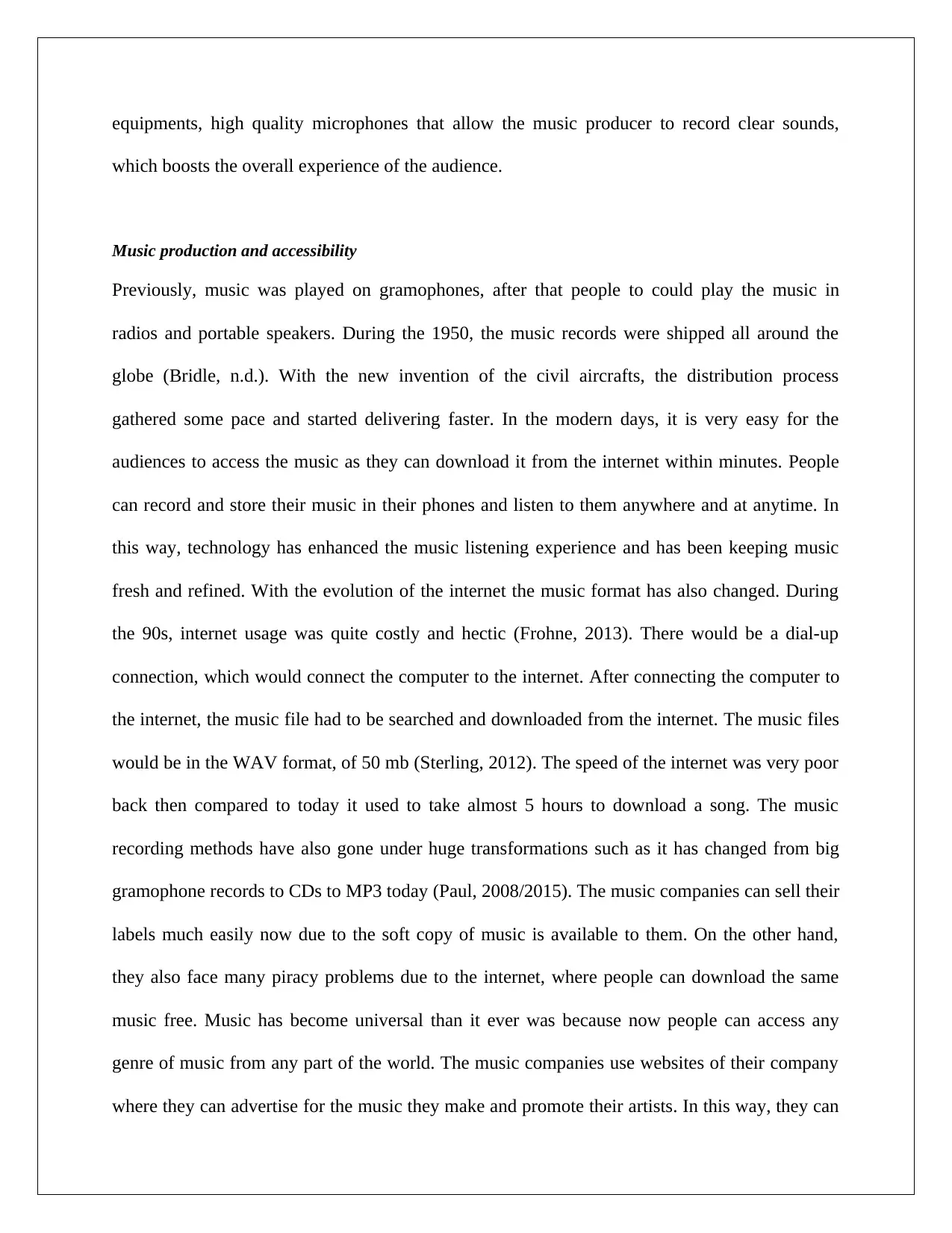
equipments, high quality microphones that allow the music producer to record clear sounds,
which boosts the overall experience of the audience.
Music production and accessibility
Previously, music was played on gramophones, after that people to could play the music in
radios and portable speakers. During the 1950, the music records were shipped all around the
globe (Bridle, n.d.). With the new invention of the civil aircrafts, the distribution process
gathered some pace and started delivering faster. In the modern days, it is very easy for the
audiences to access the music as they can download it from the internet within minutes. People
can record and store their music in their phones and listen to them anywhere and at anytime. In
this way, technology has enhanced the music listening experience and has been keeping music
fresh and refined. With the evolution of the internet the music format has also changed. During
the 90s, internet usage was quite costly and hectic (Frohne, 2013). There would be a dial-up
connection, which would connect the computer to the internet. After connecting the computer to
the internet, the music file had to be searched and downloaded from the internet. The music files
would be in the WAV format, of 50 mb (Sterling, 2012). The speed of the internet was very poor
back then compared to today it used to take almost 5 hours to download a song. The music
recording methods have also gone under huge transformations such as it has changed from big
gramophone records to CDs to MP3 today (Paul, 2008/2015). The music companies can sell their
labels much easily now due to the soft copy of music is available to them. On the other hand,
they also face many piracy problems due to the internet, where people can download the same
music free. Music has become universal than it ever was because now people can access any
genre of music from any part of the world. The music companies use websites of their company
where they can advertise for the music they make and promote their artists. In this way, they can
which boosts the overall experience of the audience.
Music production and accessibility
Previously, music was played on gramophones, after that people to could play the music in
radios and portable speakers. During the 1950, the music records were shipped all around the
globe (Bridle, n.d.). With the new invention of the civil aircrafts, the distribution process
gathered some pace and started delivering faster. In the modern days, it is very easy for the
audiences to access the music as they can download it from the internet within minutes. People
can record and store their music in their phones and listen to them anywhere and at anytime. In
this way, technology has enhanced the music listening experience and has been keeping music
fresh and refined. With the evolution of the internet the music format has also changed. During
the 90s, internet usage was quite costly and hectic (Frohne, 2013). There would be a dial-up
connection, which would connect the computer to the internet. After connecting the computer to
the internet, the music file had to be searched and downloaded from the internet. The music files
would be in the WAV format, of 50 mb (Sterling, 2012). The speed of the internet was very poor
back then compared to today it used to take almost 5 hours to download a song. The music
recording methods have also gone under huge transformations such as it has changed from big
gramophone records to CDs to MP3 today (Paul, 2008/2015). The music companies can sell their
labels much easily now due to the soft copy of music is available to them. On the other hand,
they also face many piracy problems due to the internet, where people can download the same
music free. Music has become universal than it ever was because now people can access any
genre of music from any part of the world. The music companies use websites of their company
where they can advertise for the music they make and promote their artists. In this way, they can
Paraphrase This Document
Need a fresh take? Get an instant paraphrase of this document with our AI Paraphraser
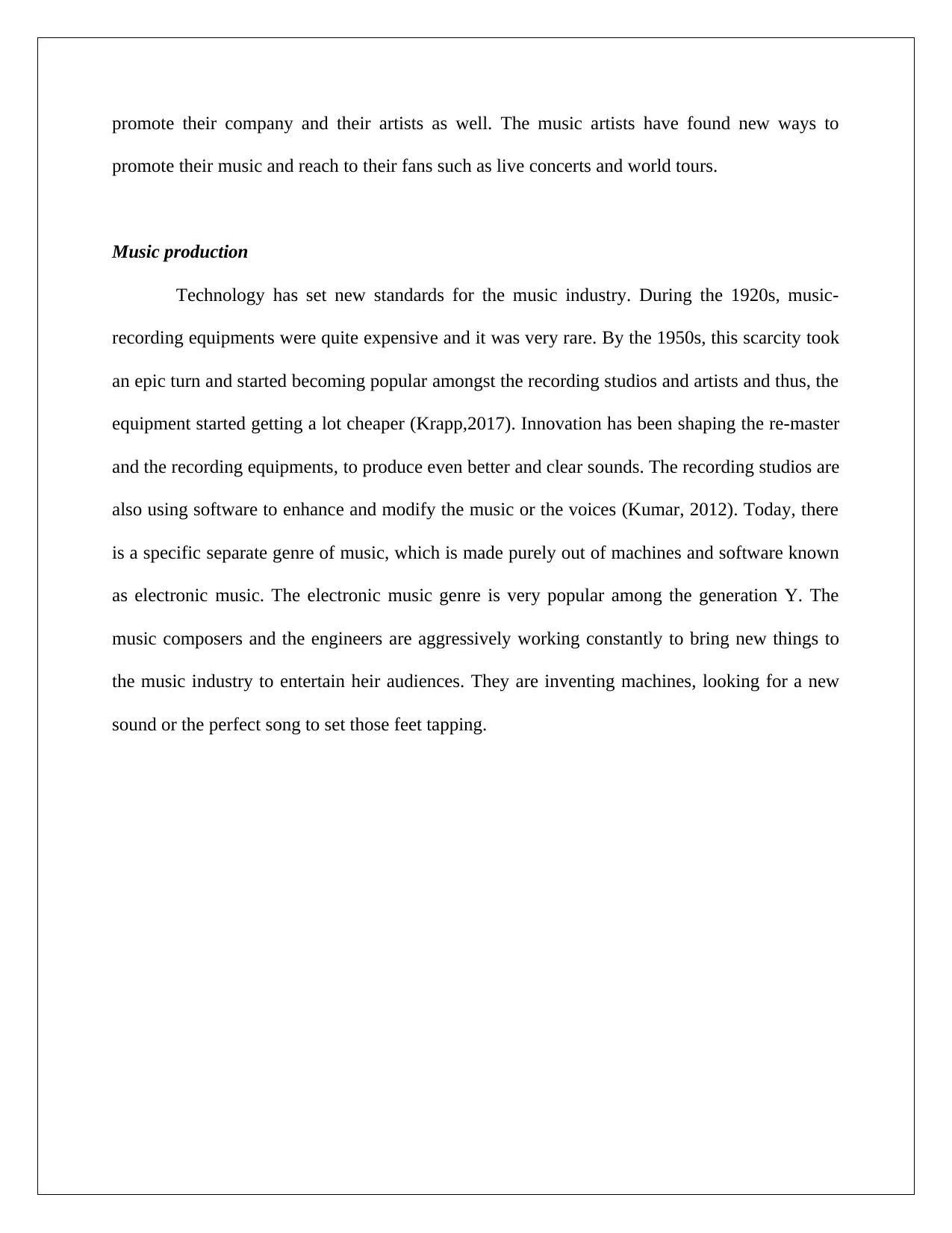
promote their company and their artists as well. The music artists have found new ways to
promote their music and reach to their fans such as live concerts and world tours.
Music production
Technology has set new standards for the music industry. During the 1920s, music-
recording equipments were quite expensive and it was very rare. By the 1950s, this scarcity took
an epic turn and started becoming popular amongst the recording studios and artists and thus, the
equipment started getting a lot cheaper (Krapp,2017). Innovation has been shaping the re-master
and the recording equipments, to produce even better and clear sounds. The recording studios are
also using software to enhance and modify the music or the voices (Kumar, 2012). Today, there
is a specific separate genre of music, which is made purely out of machines and software known
as electronic music. The electronic music genre is very popular among the generation Y. The
music composers and the engineers are aggressively working constantly to bring new things to
the music industry to entertain heir audiences. They are inventing machines, looking for a new
sound or the perfect song to set those feet tapping.
promote their music and reach to their fans such as live concerts and world tours.
Music production
Technology has set new standards for the music industry. During the 1920s, music-
recording equipments were quite expensive and it was very rare. By the 1950s, this scarcity took
an epic turn and started becoming popular amongst the recording studios and artists and thus, the
equipment started getting a lot cheaper (Krapp,2017). Innovation has been shaping the re-master
and the recording equipments, to produce even better and clear sounds. The recording studios are
also using software to enhance and modify the music or the voices (Kumar, 2012). Today, there
is a specific separate genre of music, which is made purely out of machines and software known
as electronic music. The electronic music genre is very popular among the generation Y. The
music composers and the engineers are aggressively working constantly to bring new things to
the music industry to entertain heir audiences. They are inventing machines, looking for a new
sound or the perfect song to set those feet tapping.
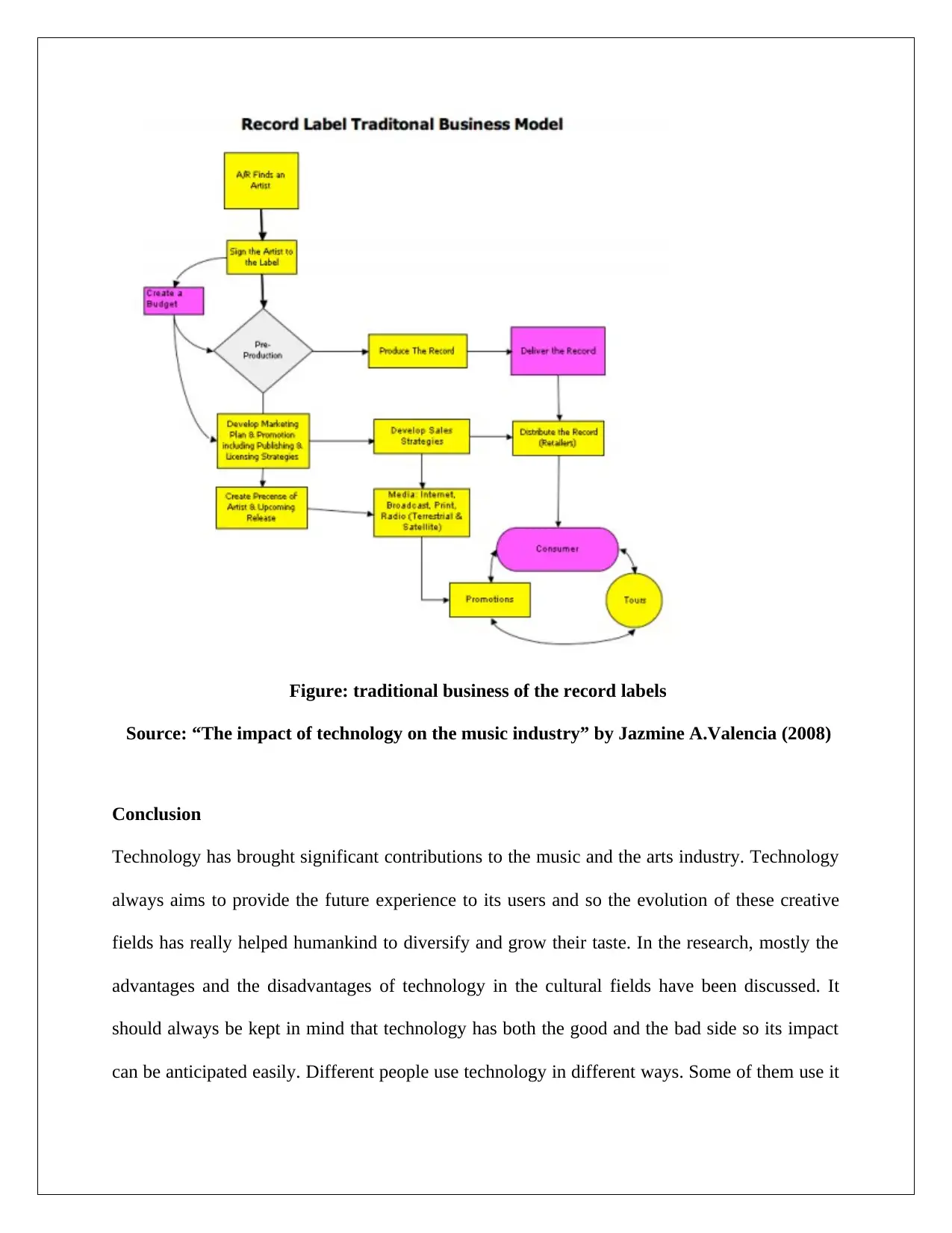
Figure: traditional business of the record labels
Source: “The impact of technology on the music industry” by Jazmine A.Valencia (2008)
Conclusion
Technology has brought significant contributions to the music and the arts industry. Technology
always aims to provide the future experience to its users and so the evolution of these creative
fields has really helped humankind to diversify and grow their taste. In the research, mostly the
advantages and the disadvantages of technology in the cultural fields have been discussed. It
should always be kept in mind that technology has both the good and the bad side so its impact
can be anticipated easily. Different people use technology in different ways. Some of them use it
Source: “The impact of technology on the music industry” by Jazmine A.Valencia (2008)
Conclusion
Technology has brought significant contributions to the music and the arts industry. Technology
always aims to provide the future experience to its users and so the evolution of these creative
fields has really helped humankind to diversify and grow their taste. In the research, mostly the
advantages and the disadvantages of technology in the cultural fields have been discussed. It
should always be kept in mind that technology has both the good and the bad side so its impact
can be anticipated easily. Different people use technology in different ways. Some of them use it
You're viewing a preview
Unlock full access by subscribing today!
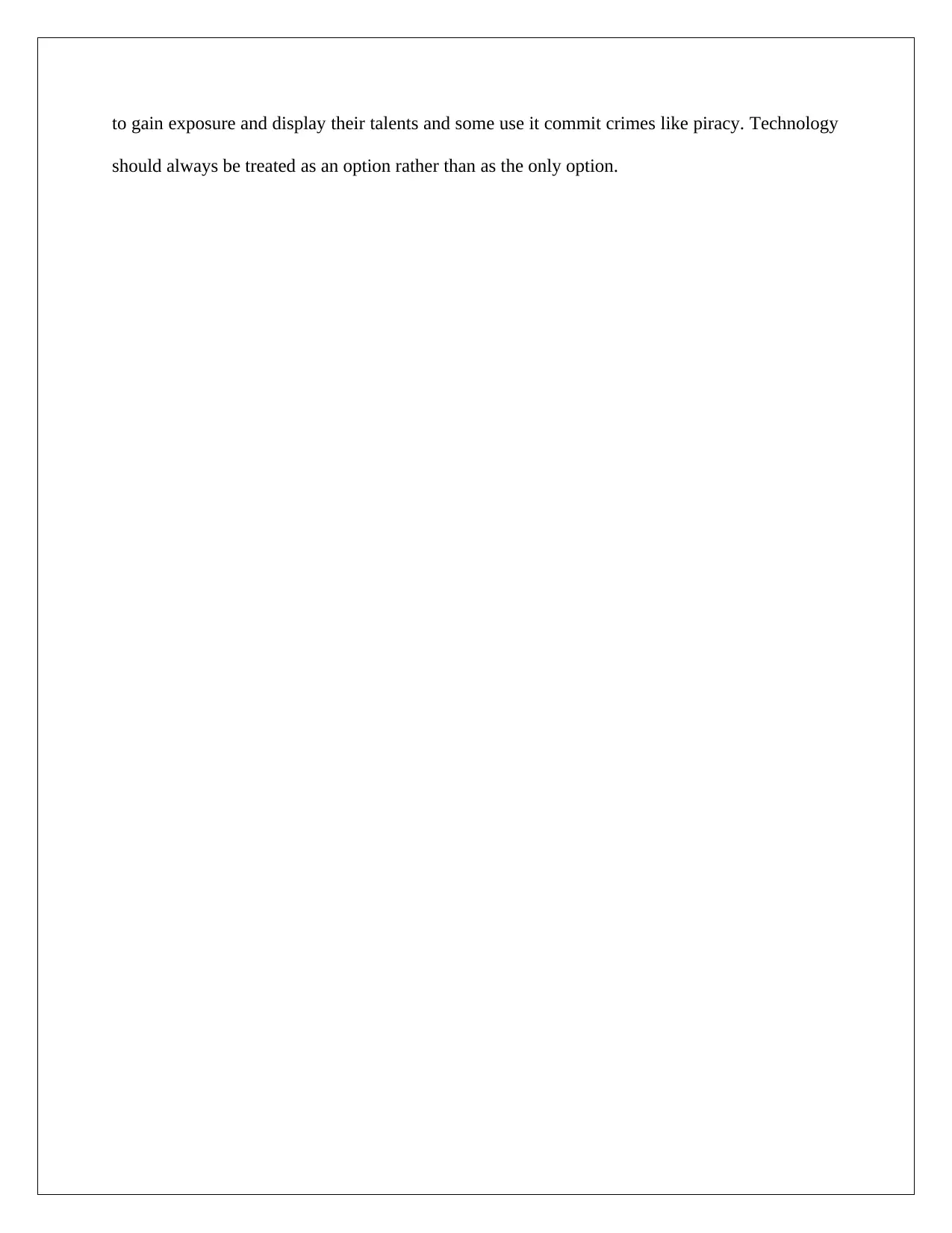
to gain exposure and display their talents and some use it commit crimes like piracy. Technology
should always be treated as an option rather than as the only option.
should always be treated as an option rather than as the only option.
Paraphrase This Document
Need a fresh take? Get an instant paraphrase of this document with our AI Paraphraser
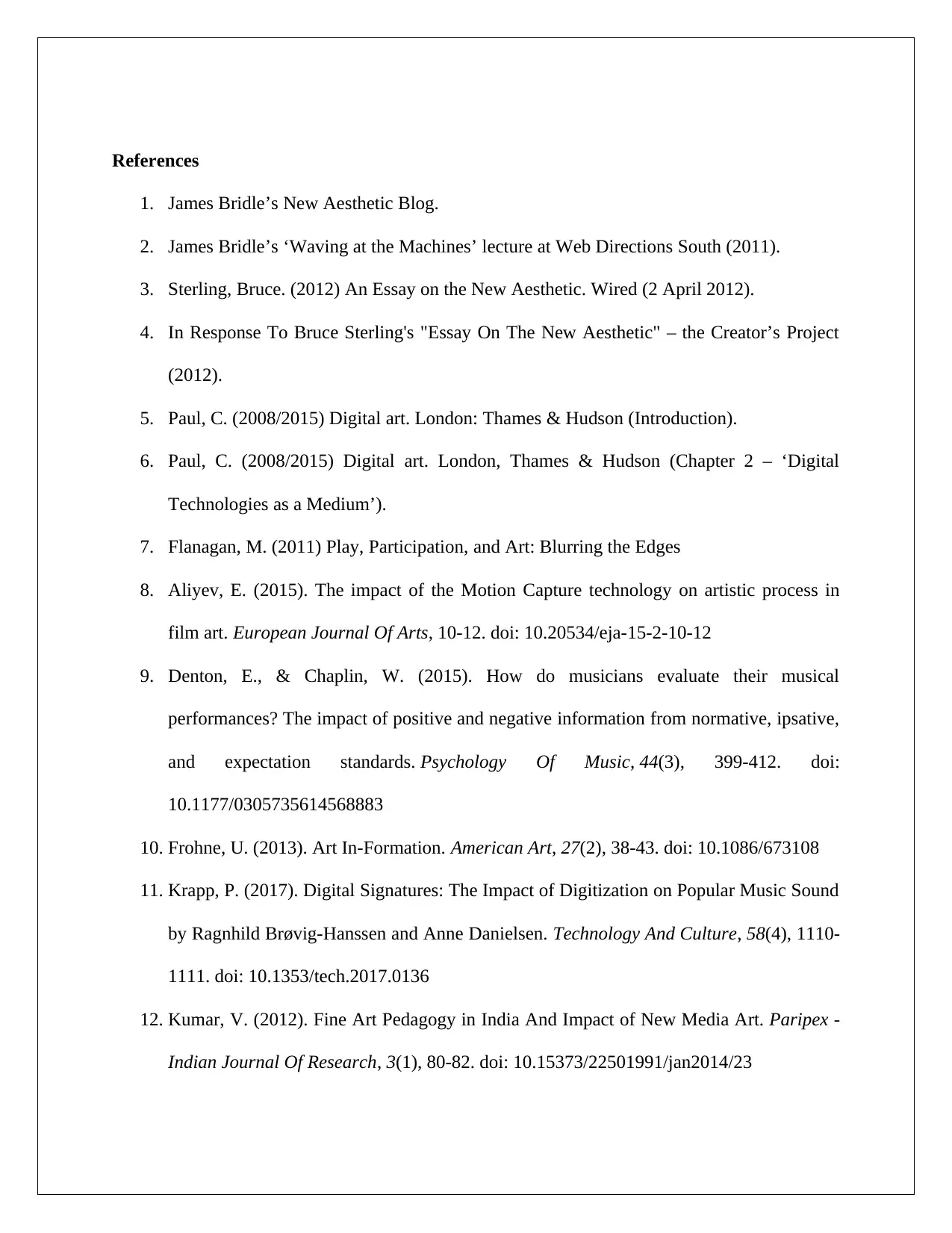
References
1. James Bridle’s New Aesthetic Blog.
2. James Bridle’s ‘Waving at the Machines’ lecture at Web Directions South (2011).
3. Sterling, Bruce. (2012) An Essay on the New Aesthetic. Wired (2 April 2012).
4. In Response To Bruce Sterling's "Essay On The New Aesthetic" – the Creator’s Project
(2012).
5. Paul, C. (2008/2015) Digital art. London: Thames & Hudson (Introduction).
6. Paul, C. (2008/2015) Digital art. London, Thames & Hudson (Chapter 2 – ‘Digital
Technologies as a Medium’).
7. Flanagan, M. (2011) Play, Participation, and Art: Blurring the Edges
8. Aliyev, E. (2015). The impact of the Motion Capture technology on artistic process in
film art. European Journal Of Arts, 10-12. doi: 10.20534/eja-15-2-10-12
9. Denton, E., & Chaplin, W. (2015). How do musicians evaluate their musical
performances? The impact of positive and negative information from normative, ipsative,
and expectation standards. Psychology Of Music, 44(3), 399-412. doi:
10.1177/0305735614568883
10. Frohne, U. (2013). Art In-Formation. American Art, 27(2), 38-43. doi: 10.1086/673108
11. Krapp, P. (2017). Digital Signatures: The Impact of Digitization on Popular Music Sound
by Ragnhild Brøvig-Hanssen and Anne Danielsen. Technology And Culture, 58(4), 1110-
1111. doi: 10.1353/tech.2017.0136
12. Kumar, V. (2012). Fine Art Pedagogy in India And Impact of New Media Art. Paripex -
Indian Journal Of Research, 3(1), 80-82. doi: 10.15373/22501991/jan2014/23
1. James Bridle’s New Aesthetic Blog.
2. James Bridle’s ‘Waving at the Machines’ lecture at Web Directions South (2011).
3. Sterling, Bruce. (2012) An Essay on the New Aesthetic. Wired (2 April 2012).
4. In Response To Bruce Sterling's "Essay On The New Aesthetic" – the Creator’s Project
(2012).
5. Paul, C. (2008/2015) Digital art. London: Thames & Hudson (Introduction).
6. Paul, C. (2008/2015) Digital art. London, Thames & Hudson (Chapter 2 – ‘Digital
Technologies as a Medium’).
7. Flanagan, M. (2011) Play, Participation, and Art: Blurring the Edges
8. Aliyev, E. (2015). The impact of the Motion Capture technology on artistic process in
film art. European Journal Of Arts, 10-12. doi: 10.20534/eja-15-2-10-12
9. Denton, E., & Chaplin, W. (2015). How do musicians evaluate their musical
performances? The impact of positive and negative information from normative, ipsative,
and expectation standards. Psychology Of Music, 44(3), 399-412. doi:
10.1177/0305735614568883
10. Frohne, U. (2013). Art In-Formation. American Art, 27(2), 38-43. doi: 10.1086/673108
11. Krapp, P. (2017). Digital Signatures: The Impact of Digitization on Popular Music Sound
by Ragnhild Brøvig-Hanssen and Anne Danielsen. Technology And Culture, 58(4), 1110-
1111. doi: 10.1353/tech.2017.0136
12. Kumar, V. (2012). Fine Art Pedagogy in India And Impact of New Media Art. Paripex -
Indian Journal Of Research, 3(1), 80-82. doi: 10.15373/22501991/jan2014/23
1 out of 11
Related Documents
Your All-in-One AI-Powered Toolkit for Academic Success.
+13062052269
info@desklib.com
Available 24*7 on WhatsApp / Email
![[object Object]](/_next/static/media/star-bottom.7253800d.svg)
Unlock your academic potential
© 2024 | Zucol Services PVT LTD | All rights reserved.





